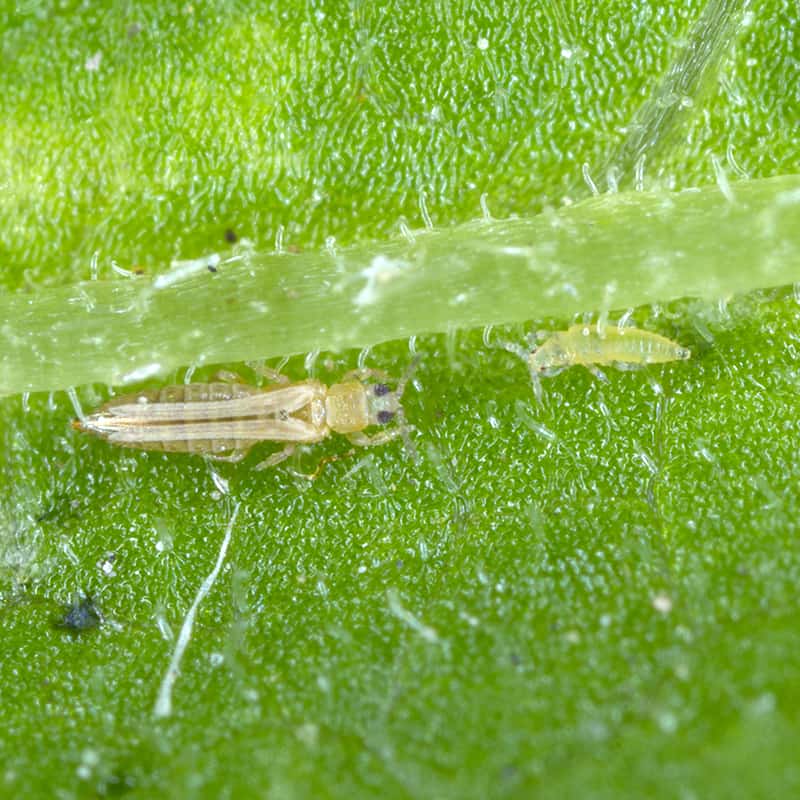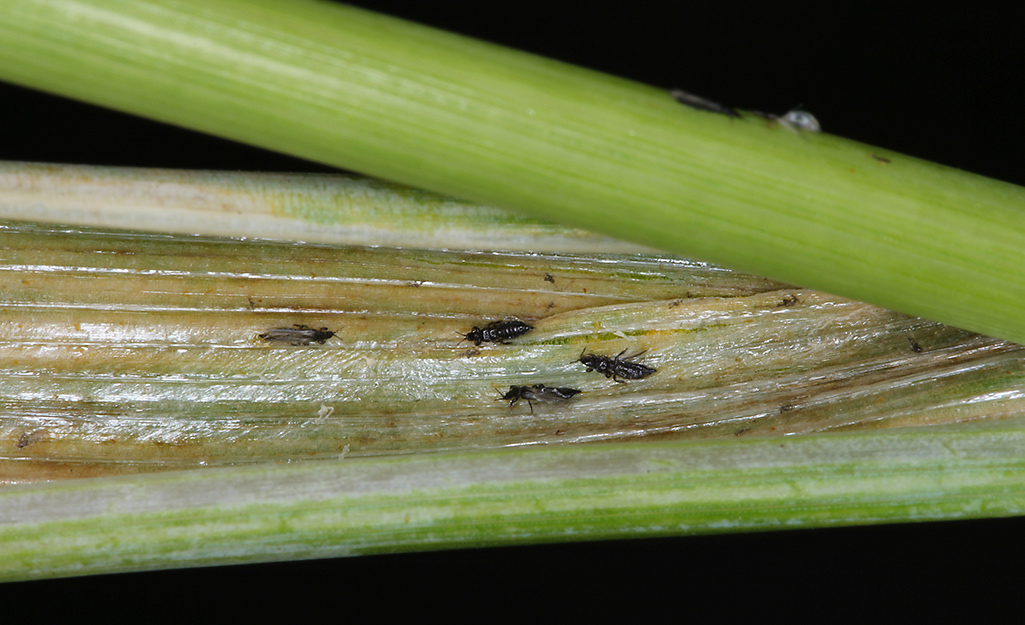Thrips is one of the most tenacious plant pests, and due to their miniscule size can be difficult to detect due to being hidden under leaves or fruit. They appear as tiny lobster-like structures.
Adult thrips insects range in color from pale to brown or black with fringed wings and are generally slender and thin in build. Their nymphs are even smaller and lighter-colored with possibly red eyes and undeveloped wings.
Insecticidal Soap
There is a wide selection of garden chemicals available to assist in controlling houseplant pests such as thrips. Many are made up from naturally-occurring ingredients and can be safely used around your plants. Some come in concentrated form that can be mixed with water to form insecticidal soap sprays; read and follow all label instructions prior to applying any product to your plants.
Use of insecticidal soap is an integral component of any holistic approach to pest management that includes houseplants. This chemical works by combining fatty acids with potassium salts to weaken soft-bodied insects’ protective cuticle. Spraying weekly or as needed has proved highly successful at keeping houseplants free from infestation.
Before using an insecticidal soap to protect a plant, it’s wise to conduct an initial test on a small portion. This will ensure the solution doesn’t damage them while giving you an idea of its length of activity. After applying the spray, allow it to sit for several minutes before rinsing it off; this will keep it from damaging plants or decreasing effectiveness.
Spraying insecticidal soap in the morning or evening when conditions are cool and damp is best, to allow time for its solution to seep into leaves and soil without drying too quickly. Apply the solution generously over all surfaces of the plant.
Water quality plays an integral part in diluting insecticidal soap effectively. Distilled or tap water that has been treated with a water conditioner should be preferred as this will minimize hard minerals such as calcium, magnesium and iron that can impede effectiveness by precipitating out fatty acid components from soap to reduce effectiveness.
Insecticidal soap can be purchased at most nurseries and garden centers as well as online. You can also make it yourself using distilled or filtered water (hard water diminishes effectiveness) with some space at the top, adding 2 tablespoons of neem oil – this combination kills thrips on contact while leaving behind a residue to deter future infestations.
Diatomaceous Earth
Diatomaceous Earth, more commonly referred to as DE, is an all-natural and effective way of killing thrips on plants in your garden. Composed from ancient single-celled algae skeletons with approximately 89% silica content, diatomaceous earth has many non-reactive qualities which make it useful in pest control; for instance cutting insects upon contact while simultaneously absorbing oil/lipid from their exoskeleton.
DE can be applied directly to plant leaves and stems as well as to the ground surrounding plants, or sprayed onto any area where thrips is active. DE is effective against all stages of thrips development – eggs through adults – making it one of the fastest ways to eliminate them as it kills on contact.
Food-grade DE can be purchased from gardening stores and online. It is suitable for use inside your house and personal indoor spaces provided that a dust mask is worn; unlike its industrial-grade counterpart which may cause respiratory conditions like silicosis.
Sprinkle a light coating of DE in your gardens, greenhouses and anywhere that has thrip infestations for maximum effectiveness against thrips and other insects that cause plant damage. DE can kill these creatures quickly but may take more time in humid environments such as Minnesota summers.
Sticky traps are another excellent way to control thrips infestation. Available at most plant supply stores and simple to use, simply hang these sticky traps where thrips infestation occurs and they will attract any that come near – once full simply take out and dispose of.
Thrips eggs can also be prevented by not leaving dead plant parts on the soil in winter, which will stop them from overwintering and becoming an issue next spring. Furthermore, keeping weed populations under control can be helpful as many serve as hosts for thrips.

Hydrogen Peroxide
Hydrogen peroxide is a mild disinfectant, widely used by many to clean cuts. This colorless liquid resembles water but contains one extra oxygen atom than usual; when exposed to certain organic materials it fizzles violently and kills off microorganisms including fungi, mycobacteria, and viruses; additionally it acts as a mild deodorizer making it readily available and inexpensive as household product.
Hydrogen peroxide and plants: some unfounded claims
Hydrogen peroxide has also been touted as helping remedy root rot due to adding oxygen into waterlogged soil, but there is no solid evidence supporting this claim. Waterlogged soil doesn’t pose too much of a problem because there’s too much moisture, rather the lack of oxygen causes root rot in plants.
When using hydrogen peroxide as a way to combat thrips, it’s essential that all instructions on the label are strictly observed. Diluting and spraying it onto plants must happen gradually until any leaves come into contact with it – otherwise thrips could come back and plague them further! Spray daily until the pest infestation has been eliminated, or repeated several times until successful. If that fails, stronger chemical insecticides may need to be employed; however, this could have other negative side-effects on plants. Therefore, it is preferable to avoid chemical insecticides if possible and instead employ methods like blue sticky traps and/or spraying with an oil-based product combining insecticide with fatty oils to smother and poison thrips.
Neem Oil
Neem oil is a natural pesticide that works effectively against thrips. Furthermore, its antifungal properties make it an attractive option if your infestation also involves fungal infections. Produced from the seeds of Azadirachta indica trees native to India and Africa that closely resemble mahogany trees in appearance, using this neem oil appropriately will not harm beneficial insects and organisms living in your garden or aquatic environments.
Neem oil contains an active ingredient known as azadirachtin that acts as a repellent and interferes with insect hormone systems, decreasing their ability to feed and reproduce. Furthermore, this component can quickly be broken down by microbes in soil or water environments.
Apply neem oil using a garden sprayer, covering all surfaces of your plants including undersides of leaves. Get into all nooks and crannies where thrips hides; as soon as the neem oil dries it continues working to protect against them – repeat applications every few days until no signs of thrips remain on your plants.
Neem oil may be less toxic to your plants than traditional chemical pesticides, but you should still conduct an initial trial application on one small area of leaves before spraying your entire plant with it. Also try spraying in early morning or late evening hours when beneficial insects and organisms may be less active and less likely to come into contact with or be adversely affected by its spray.
Neem oil can be purchased in many hardware stores, plant supply stores and even online. Make sure to read and follow all directions when applying it; similarly to insecticidal soap and hydrogen peroxide products, always rinse out your sprayer after each use to avoid an accumulation of pesticides in it.
As soon as neem oil treatments fail to combat your thrips problem effectively, it may be wise to switch up the methods you employ against it. One effective strategy could include discarding infected plant material in your trash can immediately so as not to spread pests throughout your garden or home.

